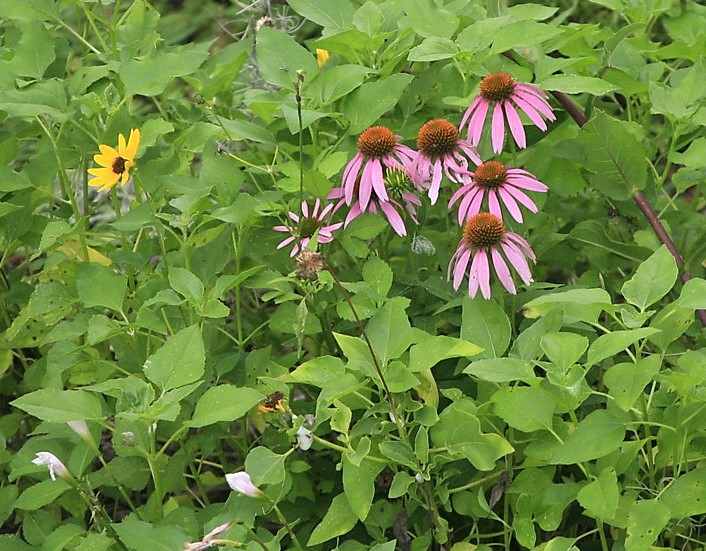Echinacea purpurea

|
|
Echinacea purpurea Common Names: Purple Coneflower, Eastern Purple
Coneflower, Black Sampson Scientific
Classification Kingdom: Plantae Clade: Tracheophytes Clade: Angiosperms Clade: Eudicots Clade: Asterids Order: Asterales Family: Asteraceae Genus: Echinacea Species: E. purpurea Binomial Name: Echinacea purpurea (L.) Moench Synonyms: Brauneria purpurea (L.) Britton, Echinacea intermedia Lindl. ex Paxton, Echinacea speciosa (Wender.) Paxton, Helichroa purpurea (L.) Raf., Rudbeckia purpurea L. Morphological Description Echinacea purpurea is a robust perennial herb, growing 0.6–1.2 m tall,
occasionally up to 1.8 m. Key features include: · Stem: Erect, hairy, green to purplish, 5–10 mm thick · Leaves: Alternate, lanceolate to ovate, 7–20 cm long, 4–10 cm wide,
dark green, coarsely serrated · Flowers: Capitula 7–15 cm wide, with 15–20 pink-purple ray florets
(2–4 cm long) and orange-brown disc florets, blooming June–August · Roots: Taproot system, fibrous, aromatic, used medicinally Distribution and Habitat Echinacea purpurea is native to eastern North America, thriving in: · Regions: Prairies, open woodlands, roadsides · Range: Ohio to Georgia, west to Oklahoma and Iowa · Climate: Temperate, 15–30°C, rainfall 600–1,000 mm annually · Soil: Well-drained, loamy, pH 6.0–7.0 · Elevation: 50–1,000 m Ethnopharmacology Echinacea purpurea, commonly known as purple coneflower, is a
well-known medicinal herb native to North America and widely used in
traditional and modern herbal medicine. It is prized for its immune-boosting
properties and is commonly used to prevent and treat colds, flu, and other
upper respiratory infections.The plant contains a range of bioactive compounds
such as alkylamides, caffeic acid derivatives (e.g., echinacoside),
polysaccharides, flavonoids, and essential oils, which contribute to its
medicinal effects. Echinacea purpurea is known for its immunomodulatory,
anti-inflammatory, antiviral, and antioxidant properties. It stimulates the
activity of white blood cells, enhances phagocytosis, and supports the body’s
natural defense mechanisms. Additionally, it exhibits wound-healing and mild
antibacterial effects and is sometimes used topically for skin irritations,
burns, or cuts.While many studies support its use in reducing the severity and
duration of colds, evidence varies, and results can depend on the specific extract
and formulation used. Overall, Echinacea purpurea is considered safe for
short-term use, though people with autoimmune disorders or allergies to plants
in the daisy family (Asteraceae) should exercise caution. · Immune Support: The roots are used for colds; E. purpurea display multiple immune-modulatory
activities, comprising stimulation of certain immune functions such as
phagocytic activity of macrophages and suppression of the proinflammatory
responses of epithelial cells to viruses and bacteria, which are manifested as
alterations in secretion of various cytokines and chemokines(Hudson, 2012). · Antibacterial: Leaf extracts are used traditionally to fight infections. · Antiviral: Cheyenne used it for flu; reduces HSV-1 replication (50% at
200 µg/mL). Recent studies on the
standardized preparation Echinaforce (EF), which consists of ethanol extracts
of Echinacea purpurea (95% aerial parts and 5% roots), have demonstrated its
strong virucidal activity against various membrane-containing viruses. The preparation was effective against HSV-1, respiratory syncytial
virus, all tested human and avian strains of influenza A virus, and influenza B
virus. Additionally, rhinovirus and feline calicivirus were also susceptible at
the relatively high EF concentrations recommended for oral use.. At a 1:10
dilution (equivalent to 1.6 mg/mL dry weight/volume), EF was able to eliminate
at least 10⁵ infectious viruses through direct contact. However, adenoviruses
were found to be resistant (Hudson, 2012). · Wound Healing: Kiowa applied poultices to burns; enhances fibroblast
proliferation (40% at 50 µg/mL) (Rininger et al., 2000). · Anti-inflammatory: Pawnee used it for pain; reduces IL-6 by
25% in vitro (Zhai et al., 2007). ⚠ Toxicity Profile: LD₅₀ > 2,500 mg/kg in rats (safe orally);
allergic reactions (rash, anaphylaxis) in Asteraceae-sensitive individuals.
Avoid in autoimmune diseases or pregnancy without medical advice (Barnes et
al., 2005). Additional Uses · Cultivation: Ornamental in gardens, attracts bees and butterflies · Preparation: Teas (1–2 g dried root), tinctures (1:5 ratio), capsules
(300–500 mg) · Ecological: Supports prairie restoration, drought-tolerant · Commercial: Herbal market leader, $28M annually in U.S. (Blumenthal,
2003) References
External Links More Pictures |
|
| Compounds of Echinacea purpurea | |
| References |